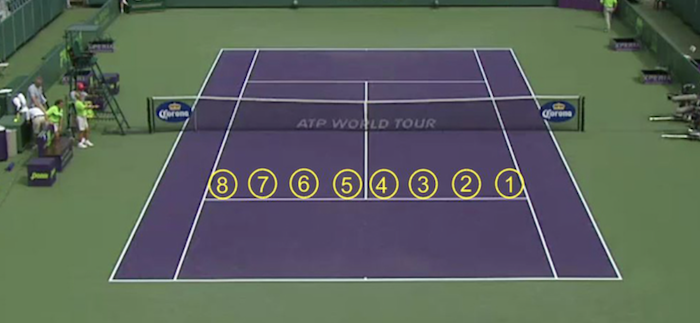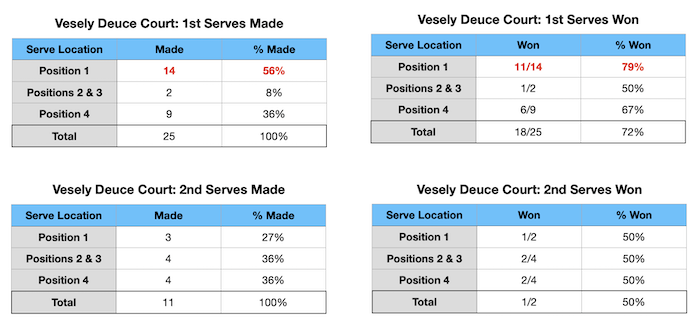DUBAI: Jiri Vesely def. Novak Djokovic 6-4, 7-6(4)
It was a stunning result. Vesely storms through qualifying to defeat Marin Cilic, Roberto Bautista Agut, and then… Novak Djokovic. How did he do it? Here are seven specific areas of the match that stood out to me analyzing the match video and the match statistics.
1: Be The First To Break
Vesely won the toss and elected to receive. Eight points later he had broken Djokovic and led 1-0 for a dream start to the match. This was a huge psychological win for Vesely as he was able to “rattle the cage” immediately against the World No. 1. He had proven very early that he belonged on this court after working his way through qualifying. Vesely was broken back in his second service game to level the score at 2-2, but nevertheless, the initial break had established himself in the match. Djokovic hit one ace in the opening game and Vesely put the other seven returns in play and only committed one error. A strong preview of what was to come.
2. Vesely: 1st Serves To Position 1


Position 1 is out wide in the Deuce court. Now, remember Vesely is a lefty, so you would expect him to serve the majority of his first serves down the T to Position 4.
He didn’t.
Vesely served 56% of all Deuce court first serves to Position 1, surprising Djokovic with a location that is typically tougher for the lefty to hit. Vesely won a very impressive 11/14 of these points. This is a crucial sub-plot of the match, as Vesely knew he had a serving spot in the Deuce court he could rely on to win points. That takes a tremendous amount of pressure off.
If Djokovic had done his homework, he would have seen this coming. Vesely upset Roberto Bautista Agut in the previous round, serving even more (62%) first serves out wide. Vesely won a dominant 8/10 first serves out wide against Bautista Agut. He only served six times to the other two locations at the body and down the T. Vesely defeated Marin Cilic 6-4, 7-6(3) in the opening round. Vesely won 7/8 serving wide to Position 1 in that match. It was once again his primary 1st serve location in the Deuce court.
Djokovic should have seen this coming. He should have been sitting on Position 1 and shut it down.
He didn’t.
3. Vesely: 1st & 2nd Serves To Position 8
Vesely surprised Djokovic with going the “other way” with his typical lefty patterns in the Deuce court. Not so in the Ad court. The lefty hit 61% (14/23) first serves out wide to Position 8 and 56% (5/9) of 2nd serves there as well. How did he do? Amazingly well!

Vesely absolutely crushed it to Position 8. He hit 61% (14) of his 1st serves in the Ad court to Position 8, winning 10. He hit five of nine second serves to Position 8 and won every single one of them. Combined, he won 15/19 (79%) of all serves to Position 8.
Djokovic failed to make a dent against the lefty slider in the Ad court. That’s the first thing you have got to protect against.
He didn’t.
4. Djokovic: Double Fault In The 2nd Set Tie-Break
Djokovic fell behind 0-3 and 2-4 in the second set tie-break, but got the mini-break back for 3-4 after Vesely missed a forehand volley wide after he served and volleyed. Now Djokovic was back on level terms serving at 3-4. He then missed his first serve in the net and decided to gamble on the 2nd serve by going for an ace down the T and missed it wide. He hit it at 186km/h (116mph). It was a roll of the dice that he simply didn’t need to go for.
The commentator said ” I can’t believe he went as hard as that with a second serve.” He basically hit two first serves at a massive moment in the match. It simply was not needed. Djokovic is without doubt one of the best tie-break players of all time. He won 17/18 tie-breaks played from Wimbledon 2019 into the Spring of 2020. He did it by reducing risk and putting as many balls in play as possible. I wrote an ATP World Tour analysis on Djokovic’s tie-break prowess. Here’s one of those paragraphs…
How Djokovic crafted his winning strategy in those three tie-breaks is the blueprint he employs for all of them. It’s about staying the course, playing the big points on his terms, trading baseline blows and not trying to pull a rabbit out of a hat or relying on spectacular shotmaking to cross the finish line. Tie-breaks are about not missing, and making the opponent uncomfortable having to hit one more shot in a pattern of play that they don’t really want to be in. Turning the screws is what the five-time Indian Wells champion relies on the most in the big moments.
For Djokovic to roll the dice going for a second serve ace only three points away from losing the match is extremely telling. He was either feeling massive pressure to win the point or didn’t trust his baseline game to beat Vesely at that moment – or both.
5. Playing Up In The Court
Djokovic’s first two wins in Dubai were 6-3, 6-3 over Lorenzo Musetti and 6-3, 7-6(2) over Karen Khachanov. Both of these players adopted a style where they set up shop more than two metres behind the baseline A LOT.

The TennisTV graphic above has Musetti and Khachanov combined on the left and Vesely on the right. The score was 6-4, *1-2 at this time. Hitting 35% of all shots in the deep zone past two metres from the baseline – as Musetti and Khachanov did – is simply not going to get the job done against Djokovic. You are giving him all the time in the world to hit the ball wherever he wants. Vesely was different. He was almost double (19% to 36%) the amount inside the baseline, taking the ball early as much as possible. Staying back was never the answer. Pressuring the front of the court was a key to this victory.
6. Baseline Points Won
Novak Djokovic is incredibly proficient at winning points from the back of the court. These numbers made me look twice…
Baseline Points Won
- Djokovic = 45.6% (36/79)
- Vesely = 50.1% (37/73)
This is a very telling element of the match. Djokovic only managed to win 45.6% of his baseline points. That’s low. That’s actually very low by his lofty standards. Vesely won just over 50% of his baseline points, which is incredibly tough to do against Djokovic. These numbers provide direct insight into how Vesely crafted his advantage when forehands and backhands went against each other from the back of the court. Vesely stood up the court and took charge.
7. Vesely Out-Rallied Djokovic
Djokovic performed better than Vesely when the points were short in the 0-4 shot range.
0-4 Shots
- Djokovic won 50
- Vesely won 44
But what happened when you collect all the points when a fifth shot landed in the court and longer?
5+ Shots
- Djokovic won 22
- Vesely won 29
Djokovic is almost always winning rallies that go 5+ shots against his opponent. Not this time. Vesely took it to him in this specific area. Djokovic rarely loses this battle. This is another crucial part of the match that loaded pressure on Djokovic.
Summary
Vesely won just three more points than Djokovic (74-71) for the match. In some ways, it was an incredibly close contest, going down to the wire in a second set tie-break. But when you break down the match into several sub-plots, Vesely enjoyed small victories all over the court. His first serves out wide in Deuce court reigned supreme. So did serving wide in the Ad court. He added a lot of pressure by staying up in the court and winning baseline exchanges. When rallies did go longer, he was outstanding there as well.
Djokovic has not played a lot of matches in recent months, so it was good to catch him in a night match on a quick court. Vesely gets a career victory, and is actually now 2-0 vs. Djokovic. But the Super Serb got three matches under his belt in Dubai and will be better off for it. And hungry to get his No. 1 ranking back as well.
Winners all around.



